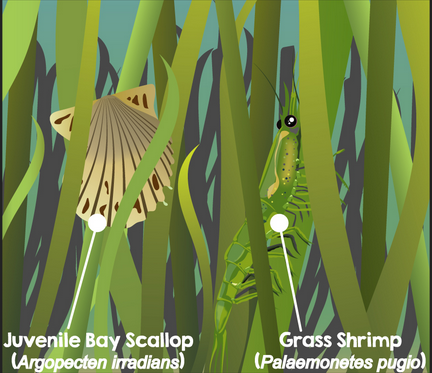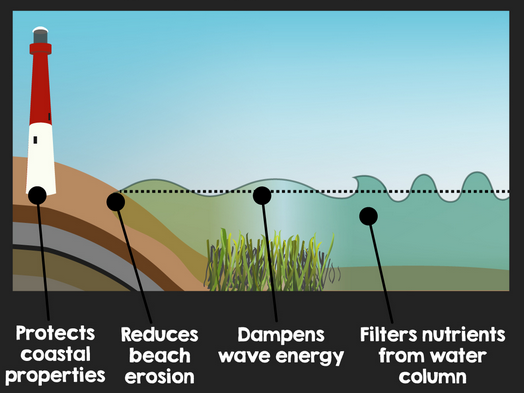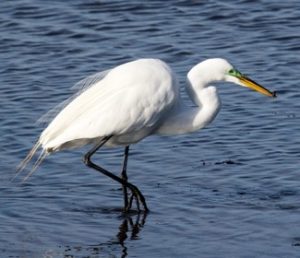Seagrasses in Barnegat Bay
Approximately 75% of the seagrass beds in New Jersey occur in the Barnegat Bay estuary. Seagrasses grow along the shallow margins of the bay in waters less than one meter in depth. Eelgrass (Zostera marina) is the dominant seagrass species in SAV beds south of Toms River, while mixed eelgrass and widgeon grass (Ruppia maritima) beds are found in the central and northern portions of the bay.

Seagrasses, like the grasses in a meadow, serve as the base of the web, supplying food to grazers and energy to the entire ecosystem. Seagrasses provide habitat and food for many recreationally and commercially important estuarine and marine species, such as bay scallop (Argopecten irradians), blue mussel (Mytilus edulis), blue crab (Callinectes sapidus), and weakfish (Cynoscion nebulosus). Seagrass beds also serve as important spawning and nursery grounds for finfish populations in the estuary.

In addition to providing valuable habitat, seagrasses play a significant role in nutrient cycling, carbon sequestration, filtering of essential elements, sediment stabilization, and wave dampening. These ecosystem services provide many benefits to coastal communities.

Seagrasses are excellent indicators of water and sediment quality. By assessing the condition of seagrass beds over time, it is possible to establish accurate trends in the condition of the bay. Seagrasses are impacted by water nutrient levels, elevated water temperatures, ice scouring, damage from boat props and anchors, disease, light intensity fluctuations caused by dredged or storm-tossed sediments, and excessive growth of algae.
Unfortunately, major declines in biomass and percent SAV cover have been reported in some sectors of the estuary since the 1970s (Bologna et al., 2000). A more recent study revealed an ongoing decline in biomass and percent cover of bay bottom (Kennish et al., 2009) attributed to increasing eutrophication due to shading of the shallow SAV beds by algal blooms and attached microalgae on the stems. Additionally, the species composition of seagrass beds in the bay appear to be changing from eelgrass to widgeon, which can affect the ecosystem services provided.
Don’t Harass the Seagrass!
Learn about seagrasses and ways to protect them through his comic created by Squidtoons, a company dedicated to translating scientific research into engaging illustrations to connect the public and the scientific community. Click here to see the original Don’t Harass the Seagrass! comic, also shown below in poster format.


Effect of Warming Waters and Rising Seas on Barnegat Bay’s Seagrass Habitat
Water Temperature
Drag the slider to show the change in seagrass habitat under increasing water temperatures.
Change in Value: + ℃
Sea Level
Drag the slider to show the impact of increasing sea level on seagrass habitats.
Change in Value: + m

